Calf Contusion
Updated:
(Also known as Calf Bruise, Bruised Calf, Corked Calf, Corky, Calf Haematoma)
What is a calf contusion?
A calf contusion is a condition characterized by a bruise or ‘corky’ to the back of the lower leg, usually as a result of a direct impact.
The muscle group at the back of the lower leg is commonly called the calf. The calf comprises of 2 major muscles one of which originates from above the knee joint (gastrocnemius) the other of which originates from below the knee joint (soleus). Both of these muscles insert into the heel bone via the Achilles tendon (figure 1).
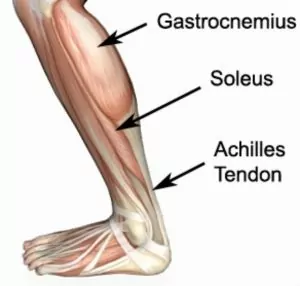
The calf is responsible for raising the heel and controlling ankle movement during weight bearing activity and has a rich blood supply. Following a direct impact to the calf, damage to the muscle fibres, connective tissue and small blood vessels of the muscle may occur. This results in a ‘bruise’ to the calf and is known as a calf contusion.
Calf contusions can range from minor contusions resulting in minimal pain and allowing ongoing activity, to severe contusions resulting in significant pain and loss of function.
Causes of a calf contusion
Calf contusions occur following a direct impact to the calf muscle from an object or person. This most commonly occurs due to a collision with another player during contact sports, such as football or rugby, or from an impact from a ball in sports such as hockey or cricket.
Signs and symptoms of a calf contusion
Patients with this condition usually feel a sudden pain in the calf muscle at the time of injury. In minor calf contusions, pain may be minimal allowing continued activity. In more severe cases, patients may experience severe pain, muscle spasm, weakness and an inability to continue activity. Patients with a severe contusion may also be unable to walk without a limp.
Patients with a bruised calf usually experience pain during activities such as walking (especially up hills), running, jumping, hopping, or standing on “tippy-toes”. It is also common for patients to experience pain or stiffness after these activities with rest, especially upon waking in the morning. Swelling, tenderness and bruising may also be present in the calf muscle, along with an inability to stretch the calf as far as usual.
In severe cases of a calf contusion, a visible increase in size of the muscle may be detected due to bleeding and swelling. In these cases patients may be unable to sleep due to pain. Occasionally the swelling and bruising may track down to the ankle joint or foot and toes.
Diagnosis of a calf contusion
A thorough subjective and objective examination from a physiotherapist is usually sufficient to diagnose a calf contusion. Further investigations such as an MRI scan or ultrasound may be required, in rare cases, to confirm diagnosis.
Treatment for a calf contusion

Members Only ContentBecome a PhysioAdvisor Member to gain full access to this exclusive content. For more details see Become a Member. Already a member? Login Now
Prognosis of a calf contusion
With appropriate management, patients with minor calf contusions can usually recover in one to three weeks. With larger contusions, recovery may take four to eight weeks or longer depending on the severity of injury. In rare cases, patients with a bruised calf can sometimes develop myositis ossificans (bony growth in the muscle). This condition is more common in severe contusions (especially those that are managed inappropriately) and may prolong recovery by weeks to months.
Physiotherapy for a calf contusion
Physiotherapy for patients with a bruised calf is vital to hasten the healing process and ensure an optimal outcome. Treatment may comprise:
- soft tissue massage (after the initial 72 hour period)
- electrotherapy (e.g. ultrasound)
- dry needling
- joint mobilization
- stretches
- anti-inflammatory advice
- the use of crutches
- Achilles tendon taping
- Calf taping
- the use of heel wedges
- applying a compression bandage
- the use of protective padding to the calf muscle to prevent re-injury
- ice or heat treatment
- exercises to improve the strength and flexibility of the calf
- education
- activity modification advice
- hydrotherapy
- establishment of an appropriate return to activity or sport plan
Other intervention for a calf contusion
Despite appropriate physiotherapy management, some patients with this condition do not improve adequately. When this occurs, your treating physiotherapist or doctor can advise on the best course of management. This may include investigations such as an X-ray (to assess for myositis ossificans), ultrasound, CT scan or MRI, pharmaceutical intervention, or referral to appropriate medical authorities who can advise on any intervention that may be appropriate to improve the condition.
Exercises for a calf contusion
The following exercises are commonly prescribed to patients with a bruised calf. You should discuss the suitability of these exercises with your physiotherapist prior to beginning them. Generally, they should be performed 3 times daily and only provided they do not cause or increase symptoms.
Your physiotherapist can advise when it is appropriate to begin the initial exercises and eventually progress to the intermediate, advanced and other exercises. As a general rule, addition of exercises or progression to more advanced exercises should take place provided there is no increase in symptoms.
Initial Exercises
Calf Stretch with Towel
Begin thiscalf stretchin long sitting with your leg to be stretched in front of you. Yourknee and back should be straight and a towel or rigid band placed around your foot as demonstrated (figure 2). Using your foot, ankle and the towel,bring your toes towards your head as far as you can go without pain and provided you feel no more than a mild to moderate stretch in the back of your calf, Achilles tendon or leg. Hold for 5 seconds and repeat10 times at a mild to moderate stretch provided the exercise is pain free.

Resistance Band Calf Strengthening
Begin this exercise with a light resistance band around your foot as demonstrated and your foot and ankle held up towards your head (figure 3). Slowly move your foot and ankle down against the resistance band as far as possible and comfortable without pain, tightening your calf muscle. Slowly return back to the starting position. Repeat 10 – 20 times providedthe exerciseis pain free. Once you can consistently perform 20 repetitions without pain, the exercise can be progressed by increasing the resistance of the band. Begin with only a few repetitions using the heavier band initially and then gradually build up to 20 repetitions over a number of days provided there is no increase in symptoms.
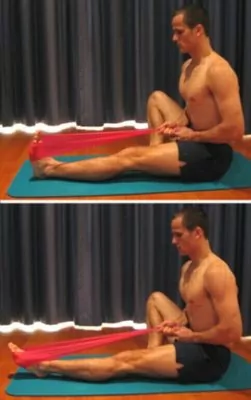
Intermediate Exercises

Members Only ContentBecome a PhysioAdvisor Member to gain full access to this exclusive content. For more details see Become a Member. Already a member? Login Now
Advanced Exercises

Members Only ContentBecome a PhysioAdvisor Member to gain full access to this exclusive content. For more details see Become a Member. Already a member? Login Now
Other Exercises

Members Only ContentBecome a PhysioAdvisor Member to gain full access to this exclusive content. For more details see Become a Member. Already a member? Login Now
Rehabilitation Protocol for a calf contusion

Members Only ContentBecome a PhysioAdvisor Member to gain full access to this exclusive content. For more details see Become a Member. Already a member? Login Now
 Physiotherapy products for a calf contusion
Physiotherapy products for a calf contusion
Some of the most commonly recommended products by physiotherapists to hasten healing and speed recovery in patients with a bruised calf include:
-
 Wheat Bags
Wheat Bags -
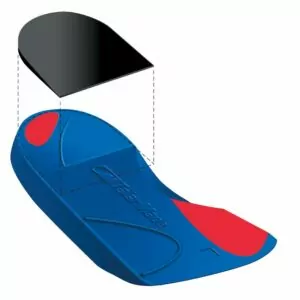 Heel Lifts (Elevators – Talar Made) (Pack of 5 Pairs)
Heel Lifts (Elevators – Talar Made) (Pack of 5 Pairs) -
 Forearm Crutches Adjustable – Standard Grip
Forearm Crutches Adjustable – Standard Grip -
 AllCare Band
AllCare Band -
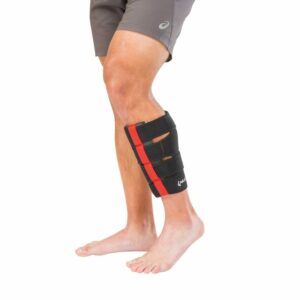 Mueller Calf Wrap
Mueller Calf Wrap -
 AllCare Tubing
AllCare Tubing -
 AllCare Spikey Massage Ball
AllCare Spikey Massage Ball -
 AllCare Instant Cold Pack (15 x 25cm)
AllCare Instant Cold Pack (15 x 25cm) -
 AllCare Foam Roller Round
AllCare Foam Roller Round -
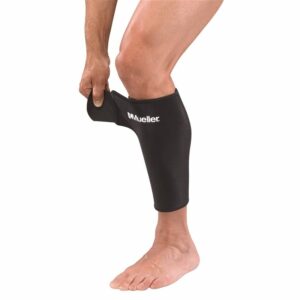 Mueller Adjustable Calf / Shin Splint Support
Mueller Adjustable Calf / Shin Splint Support -
 Tubigrip
Tubigrip
To purchase physiotherapy products for a bruised calf click on one of the above links, or visit the PhysioAdvisor Shop.
 Find a Physio for a calf contusion
Find a Physio for a calf contusion
Find a physiotherapist in your local area who can treat a bruised calf.
 More Exercises
More Exercises
- View more Calf Stretches.
- View more Calf Strengthening Exercises.
- View Massage Ball Exercises designed to improve lower body flexibility.
- View Foam Roller Exercises designed to improve lower body flexibility
 More information
More information
- View detailed information on How to use Crutches.
- View detailed information on when to use Ice or Heat.
- View detailed information on initial injury management and the R.I.C.E. Regime.
- View detailed information on a Return to Running Program.
- View detailed information on Returning to Sport.
- View detailed information on Achilles tendon taping.
- View detailed information on Calf taping.
- View our Lower Leg Diagnosis Guide.
Become a PhysioAdvisor Member
-
 Individual Membership (12 Months)$59.95 for 1 year
Individual Membership (12 Months)$59.95 for 1 year -
 Individual Membership (3 Months)$39.95 for 3 months
Individual Membership (3 Months)$39.95 for 3 months -
 Individual Membership (Yearly)$49.95 / year
Individual Membership (Yearly)$49.95 / year -
 Individual Membership (Monthly)$15.95 / month
Individual Membership (Monthly)$15.95 / month

Link to this Page
If you would like to link to this article on your website, simply copy the code below and add it to your page:
<a href="https://physioadvisor.com.au/injuries/lower-leg/calf-contusion”>Calf Contusion – PhysioAdvisor.com</a><br/>PhysioAdvisor offers detailed physiotherapy information on calf contusion (bruised calf)including: symptoms, causes, diagnosis, treatment, exercises, rehabilitation protocol, physiotherapy products and more...
Return to the top of Calf Contusion.
